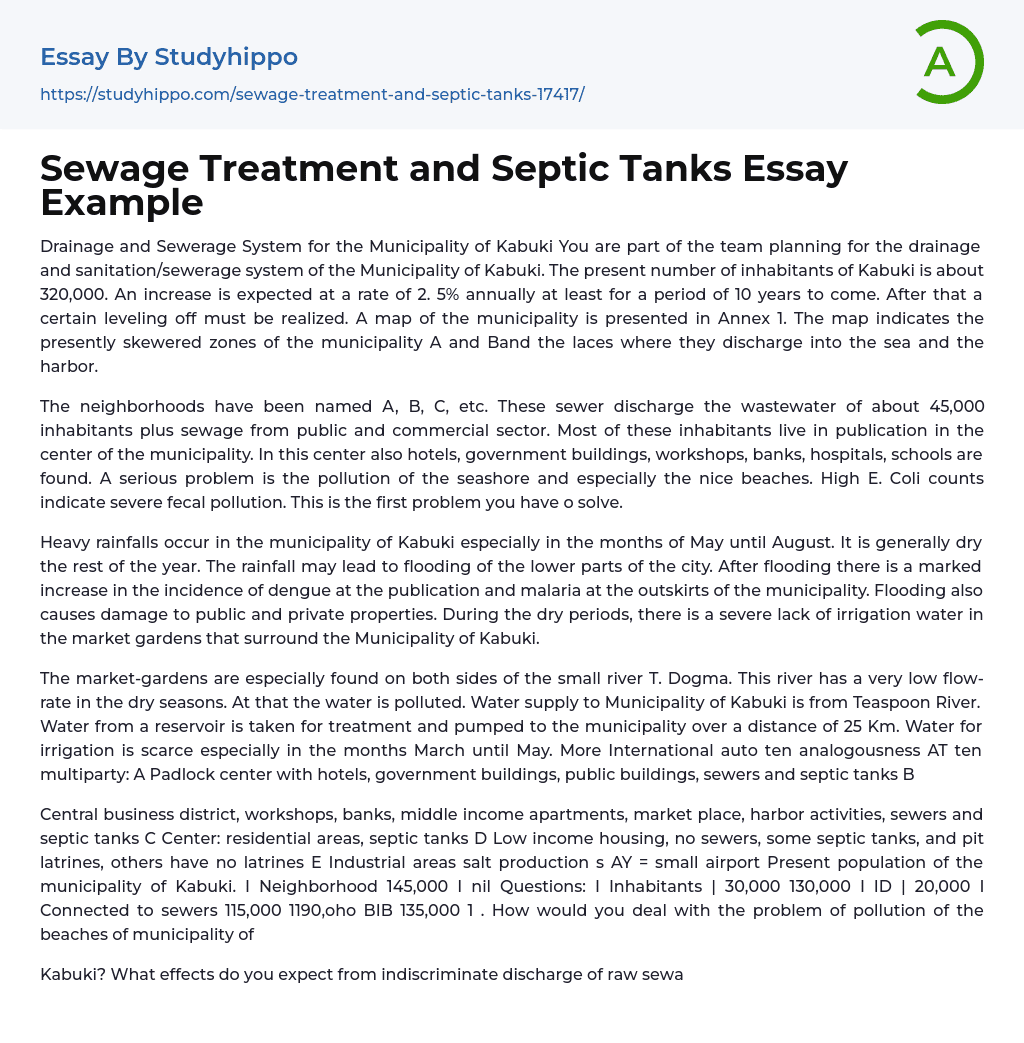The Municipality of Kabuki is currently planning the drainage and sewerage system. The population of Kabuki is about 320,000 and is expected to increase by 2.5% annually for the next decade, with a leveling off afterwards. A map in Annex 1 illustrates the current sewer areas A and B in Kabuki, as well as their discharge locations into the sea and harbor.
Kabuki has several neighborhoods named A, B, C, etc., which are responsible for wastewater disposal for approximately 45,000 residents. These areas also handle sewage from public and commercial sectors. Many residents live in the central part of the municipality where various establishments such as hotels, government buildings, workshops, banks, hospitals, and schools are located. Pollution along the seashore is a significant problem in Kabuki that particularly affects its beaches. High E. Coli counts indicate severe fecal pollution requiri
...ng immediate attention.
Kabuki experiences heavy rainfall between May and August while remaining dry throughout most of the year. This rainfall often leads to flooding in lower parts of the city. Consequently, there is a noticeable increase in dengue cases within the central area after flooding occurs while malaria cases rise on the outskirts of Kabuki municipality. Flooding also causes damage to both public and private properties.Additionally, there is a significant shortage of irrigation water in the market gardens surrounding the Municipality of Kabuki during dry periods. These market-gardens are mainly situated on both sides of the small river T. Dogma, which experiences low flow-rate and polluted water during dry seasons.
The Municipality of Kabuki gets its water supply from Teaspoon River. Water is treated and pumped 25 Km to the municipality from a reservoir. This limited water suppl
poses challenges for irrigation, especially from March to May.
Moreover, the municipality has various areas with different characteristics. The International auto ten analogousness AT ten multiparty includes:
A: a Padlock center containing hotels, government buildings, public buildings, sewers, and septic tanks.
B: a central business district consisting of workshops, banks, middle-income apartments, market place, harbor activities, sewers, and septic tanks.
C: a center comprising residential areas and septic tanks.
D: low-income housing without sewers or with some septic tanks and pit latrines.
E: industrial areas involving salt production and a small airport.
The current population of the Municipality of Kabuki is 145,000 residents. Regarding inhabitants' information:
- There are 30k residents connected to sewers,
- And 20k residents without connection.
One question addresses pollution management on the beaches of Kabuki Municipality when discussing effects and solutions.The text discusses various aspects related to the discharge of raw sewage and the consequences it can have. It mentions that flooding can cause property damage, water scarcity affects market gardens, and different areas within the municipality have different infrastructure characteristics. The current population data provides information about sewer connections in the municipality. The questions and decisions that need to be addressed include locating future sewage treatment stations and justifying their locations, discussing whether a combined or separate sewer system is appropriate for the municipality, determining the layout of stormwater drainage systems in different sections of town (A, B, C, D), selecting a suitable sewerage system based on specific parts of the city under consideration, addressing sanitation and sewerage situations for residents in section E, indicating the tracks of main sanitary sewer lines along with justification for their placement and identifying necessary pumping stations for sewage. Finally, an appropriate type
of wastewater treatment system will be chosen and explained.The text discusses the options for treated sewage effluent, which include either discharging it to bodies of water or reusing it. If reuse is chosen, the preferred purpose or type of reuse will be specified. Additionally, Annex 1 serves as a reference for the Teaspoon River.
- Building essays
- Academia essays
- Higher Education essays
- Language Learning essays
- Studying Business essays
- Education System essays
- Study essays
- First Day of School essays
- Scholarship essays
- Pedagogy essays
- Curriculum essays
- Coursework essays
- Studying Abroad essays
- Philosophy of Education essays
- Purpose of Education essays
- Brainstorming essays
- Educational Goals essays
- Importance Of College Education essays
- Brown V Board of Education essays
- The Importance Of Higher Education essays
- Online Education Vs Traditional Education essays
- Academic And Career Goals essays
- Academic Integrity essays
- Brown Vs Board Of Education essays
- Distance learning essays
- Technology in Education essays
- Vocabulary essays
- Writing Experience essays
- Importance of Education essays
- Early Childhood Education essays
- Academic Degree essays
- Academic Dishonesty essays
- School Uniform essays
- Academic writing essays
- Cheating essays
- Bachelor's Degree essays
- MBA essays
- College Life essays
- Grade essays
- Diploma essays
- Phonology essays
- Sentence essays
- Filipino Language essays
- Pragmatics essays
- Millennium Development Goals essays
- History Of Education essays
- Graduate School essays
- Middle School essays
- School essays
- Special Education essays




